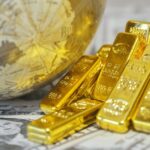Weekly Market Report 6/13/11
GOLD
Last Friday Gold closed at $1,528.60, down $14.20 per ounce for the week. The high/low price of Gold last week ranged from $1,555 to $1,526.70.
Last week’s negative news that affected the gold market was primarily:
- Fed Chair Ben Bernanke’s speech on Tuesday giving no indicator of a QE3 coming.
- Dow Jones Industrial Average down 200 points for the week
- 3% increase in the value of the U.S. Dollar versus the Euro
- 2% Drop in Crude Oil, caused by a failure of OPEC to establish production targets.
- More negative U.S. economic news, including no headway on lifting the U.S. debt ceiling.
While the positive news for Gold was primarily:
- China’s foreign exchange regulator said on Tuesday that Beijing should guard against risks from excessive holdings of dollar denominated assets. Chinese Gold demand keeps growing.
- The World’s Central banks continue to add gold to their reserves, as the Russians increased their gold holdings by 44 %, reaching $516 Billion Dollars over the last 5 months.
- Steve Forbes called for a true U.S. Gold Standard, which would require $5,000 an ounce gold as well the U.S. Government removing $8 trillion in paper currency from circulation (versus a $40,000 an ounce gold price.)
- Eurozone problems with the Greek Debt problem appeared to have been given a temporary fix last week, but today Standard and Poor’s downgraded Greece’s debt to triple C, just two notches above default.
SILVER
Silver traded in a narrow range all week, with a high/low ranging from $37.86 to $36.06.
Last week silver closed down 10 cents at $36.32 an ounce on moderate trading volume. I would expect Silver to open lower this week and end the week near the highs. Other than the list of positive and negative news events listed above, there wasn’t anything specific that should have caused any additional volatility in the Silver market.
WHAT IS THE BEST GOLD AND SILVER INVESTMENT?
To evaluate what is the best way to own Gold and Silver we need to look at the options. The options are Physical Gold/Silver, Gold/Silver Mining Shares or Gold/Silver Mutual Funds.
I didn’t include Gold/Silver ETFs because it tracks the physical price with a few major differences. I looked at values dating back both 1 year, and to the beginning of 2011, to calculate the results.
I used the following as true indicators of the market prices:
Spot Gold and Silver Prices,
Gold Mining Share Index (GDX)
Fidelity Select Gold Shares Mutual Fund (FSAGX)
Silver Mining Share Index (SIL)
HERE ARE THE RAW STATISTICS
6/10/2010 to Date (1 year)
Spot Gold $1,217.50 to $1,528.60, Increase of 25.55%
Gold Mining Share Index (GDX) 50.79 to 53.80 (with .40 Dividend) Increase of 5.9%
Fidelity Select Gold FUND (FSAGX) 46.50 to 49.38 (with 3.51 Dividend) Increase of 6.19%
Spot Silver $18.61 to $36.26, Increase of 94.84%
Silver Mining Share Index (SIL) 14.75 to 23.35 (with .24 Dividend) Increase of 58.30%
1/1/2011 to Date (6/10/2011)
Spot Gold $1,421.40 to $1,528.60, Increase of 7.54%
Gold Mining Share Index (GDX) 61.47 to 53.40, Decrease of -13.13%
Fidelity Select Gold FUND (FSAGX) 53.11 to 47.62 (with 1.75 Dividend) Decrease of -10.34%
Spot Silver $30.50 to $36.26, Increase of 18.88%
Silver Mining Share Index (SIL) 27.13 to 23.11, Decrease of -14.82%
It is clear from the above statistics that physical gold has increased over 400% more than stocks and funds did in the past year. Physical Silver increased 60% higher than stocks in the past year. If you use the year to date (YTD) numbers, the results show both physical gold/silver are higher and that the mining stocks and funds have decreased substantially, showing that this trend has accelerated.
What is causing that trend to develop and, more importantly, WHY?
Disconnect Between Bullion and Mining Stocks
Many market analysts who discuss the disconnect between Bullion and Stock/Mutual Fund pricing believe that it’s an anomaly in the market and it will self-correct quickly. Many market gurus mentioned the fact that some mining companies have hedged future production and are not benefitting from the recent high prices. A popular excuse is that the relationship between physical gold and mining stocks got disrupted when the financial markets went haywire in 2008, and equities tumbled while physical metal increased.
The most recent statement in an article by Peter Koven in May 2011 said:
“that the analysts themselves are pricing in numbers that are much too low when they calculate what these companies are worth. While most analysts are using a gold price of roughly US$1,500 an ounce for 2011, their long-term targets are closer to US$1,000, which affects their earnings estimates.”
Although many of these market analysts are highly respected, my research leads me to say, “None of the above.”
I believe that the problem is the increasing risk of labor costs and third world producing countries hiking their export fees, along with the strong possibilities of union strikes and government nationalization. This will cause physical precious metals to increase, while stocks continue to drop.
Let me provide a few examples of what is concerning me….
We start with Peru, the World’s No. 1 exporter of Silver and the No. 6 exporter of Gold. On June 7, 2011, President elect Ollanta Humala provoked widespread fears he would lead a wave of nationalizations and higher taxes on foreign companies. Incoming President Humala has suggested Peru could impose a windfall tax of up to 40 per cent on mining companies, and also raise the 30 per cent rate that miners currently pay. Humala has stated that mining companies whose profits have swollen on lofty global commodities prices should fund social programs in a country where a third of the people are poor despite a decade-long economic boom. This feeling is shared by many under-developed countries with natural resources.
Chile has recently increased its mining tax from 4-5% of operating profit to 4-9% on precious metal mines. Chile plans to tighten its safety laws after the collapsed mine at San Jose that highlighted the lack of regulation in the mining sector in the country. This will add additional cost to all gold and silver mining operations.
Bolivia, In April some mining companies with operations in Bolivia sold off on concerns from President Morales stating that Bolivia was planning to nationalize mines owned by Pan American Silver. The unions demanded increases in compensation and requested that the government not take control of the mines.
Tanzania, one of Africa’s top gold producers, is considering a "super profit" tax on earnings from minerals as one of the ways to fund its five-year development plan, according to documents seen by Reuters. The move follows similar steps in other producer countries that have sought to increase fiscal revenue from the mining industry and to take advantage of rising prices.
Australia was among the first to consider a hefty resource tax, but it had to climb down from initial proposals for a headline tax of 40 percent after pre-election talks with mining giants like BHP Billiton and Rio Tinto.
The risk of continued wage inflation for miners is a Global problem.
The reasons for cost inflation vary by region, but top precious and base metals producer nations South Africa, Australia, Chile and Canada all have strong domestic currencies, rising labor costs, and surging energy costs in common.
Barclays Capital analyst, Gayle Berry, said that one of the top causes of inflation has been labor, with an acute shortage of skilled manpower looming in some countries. Canada’s mining sector, she said, is forecast to have a shortfall of almost 100,000 workers in the next decade, with 65 percent of the hiring requirement simply to replace retired workers. Plugging that hole will be tough and expensive. "The first impact is on mine production costs, which are going to continue rising, and the second impact is the potential for delays to new projects, or at the very least a slower realization of projects in the pipeline," Berry said.
Western Australia is a flashpoint for labor costs, with mining companies competing for skilled labor with several large natural gas projects.
"Investors are wary of investing in new gold mining projects in Australia because of the high cost of achieving production in that region," said John Meyer, a mining analyst at Fairfax.
In South Africa, the National Union of Mineworkers is demanding an above-inflation 14 percent rise in wages this year.
At the same time, the currencies of producer countries (including South Africa, Australia, Canada and Chile) has risen, eating into profits of companies that sell their metals in dollars and pay their costs in local currencies. The South African rand has gained 14 percent in the past 12 months, while the Australian dollar is up around 30 percent compared with one year ago.
Another fear of owners of mining shares was just announced today. The U.S. Department of Justice announced that Hecla Mining has agreed to pay more than $263 million to settle environment claims. Just add this to my list.
I continue to read more and more reports in mining publications and global newspapers of precious metal mining companies lowering production targets and seeing increases in production and labor costs. Add these negatives to the governmental risks, and the picture for the value of mining shares isn’t looking good.
Conclusion:
I am recommending selling stocks and funds with mining operations in the many countries mentioned above and switching into physical gold and silver. Physical Gold and Silver ownership will increase should there be nationalization of mining, or as costs increase and production decreases.
Owning physical metal offers many advantages over paper gold/silver ETFs like GLD and SLV.
I’ll discuss that statement in next Week’s Precious Metal and Rare Coin Report.
Barry Stuppler






